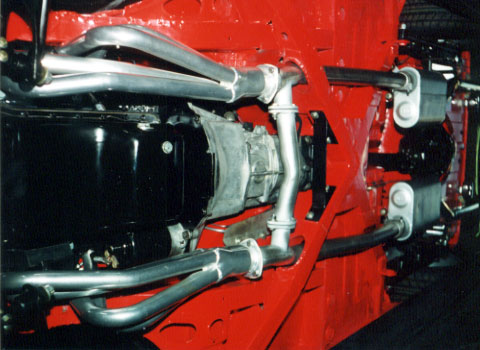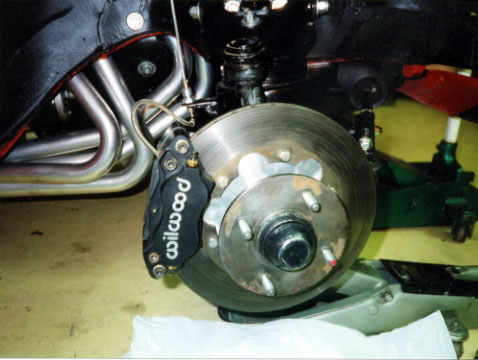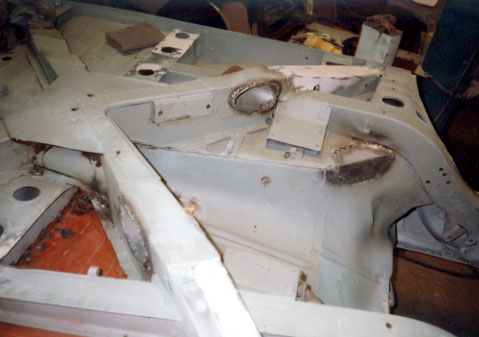High Performance Tiger Exhaust System

An Article by Larry Paulick
April, 2001
Preface: Larry Paulick has added yet another in a series of Performance Tuning articles he is producing from his own experience. Be prepared for some really fine articles.
Editor
Page 1
The System:
The Tiger exhaust system in it’s stock form, is adequate for the stock motor. If you would like the car to breath better, or if you have made changes to the intake manifold, and carb over the stock system, then you need to really build an exhaust system to match the intake side.
We all know, that the engine is just a air pump, and so if changes are made to one part, then the other parts must be adjusted to act as a coordinated system.
New manifold, carbs, and tube headers are very common in Tigers. The problem is that the body X-Frame exhaust pass through limit the size of the exhaust.
On a stock system, with a 1 3/4” diameter exhaust, the pipes are further crimped to go through this pass through, and at the rear portion of the cross frame. You make the straw, even smaller, when you crimp it.
There are better exhaust pipes and mufflers available, and I believe Jeff Cushing (Tiger Technologies) still offers a 2” diameter exhaust system. Much better than stock.
But first think of the Intake and Exhaust as a System. What goes in, must be able to get out.
What I have is a 1990 Mustang 5.0 L engine with a Edelbrock F4B manifold, the LAT-1 option, with a 600 CFM Double Pumper Holley, Rick’s Headers, very good product, that have been coated by Jet Hot, 2 1/4” diameter exhaust pipes, a H Pipe after the headers, Flowmaster Mufflers, and a revised exhausts pass through that allows the Full 2 1/4” diameter exhausts pipe to run the full length of the car from header to exhaust tip.
Intake and Exhaust System Considerations:
Some stuff I have learned over the years of reading car magazines, especially with dyno tests, which is the real test for any change.
- Size your carb to your engine size and maximum rpm. My carb is just over the top at 600 cfm, but with tuning, is has not hurt performance. Another story.
- Look at your manifold for your anticipated rpm range, ie idle to 5,500 rpm, or 2,500 to 6,500 rpm. This will determine how your engine and carb match. Manufacturers like Holley, and Dealers like Summit, can help you size your carb and manifold for your engines size and rpm range, as well as if it is a stick vs auto trans.
BTW, I called Edelbrock, and said that I had a Tiger that weighed about 2,400 pounds, had a 5.0L engine, stick trans, and I did not want to go much pass 6,000 rpm’s . I still have the stock cam, even though this engine has a roller cam and now roller rockers..
Funny, I told them I had the Old F4B manifold and they said that was still a very good manifold, good from about 1,200 rpm to 5,500 rpm’s. Made My Day, as I was ready to go to another of their manifolds. I liked the old manifold, and this really fit within the rpm range of what I wanted.
- Next, you have to decide on a exhaust manifold. The stock manifold is very restrictive, and never intended for performance. Even the Tri Y LAT-27 Headers, were reported to only add a few hp and torque, according to the Book of Norman. They are also very rare, and maybe very pricey..
I had a set of still in the box, NOS LAT-73 Bellinger Headers, with all the original stuff, including the box, instructions, and brand new headers, with side out exhaust to muffler connections. Well, the tube were thin material, the side out to the muffler system, was made for really running an open exhaust, and was restrictive in it’s design connected to a muffler system..
So, I purchased a set of Headers that Rick, of Sunbeam Specialties had made for him,. They are quality, 16 gauge metal, fit the Tiger, are of a more modern design, and with a little adjustment around the motor mounts fit easily.

- The next issue, is the added expense of coating the headers with a long lasting coating. I chose Jet Hot, for lots or reasons, but there are other good coatings available, and you decide..
The choice was really a No Brainier. The life of the header is extended significantly, important if you have ever changed headers. Also, over the life of an uncoated header, it not only rusts internally, or what looks like rust, but is really metal fatigue. What this does is slow down the hot gasses, and over time not only reduces the life of the header metal, but reduces the hp and torque up to 5%. Bummer..
The costs is about $250 over the cost of the headers, but for the above reasons, I went that way. Besides it looks nice, and I hate rust..
You can paint with HTP (High Temperature Paint) but they just don’t have the properties of these coatings.
- Well, we are now back to the next part of the exhaust, the H Pipe. It connects the two exhaust pipes and does several things. First, is increases the torque at lower speeds, and secondarily, reduces the db of the exhaust system over the entire rpm range..
How much increase in torque, well most articles say about another 5-10%, and a lowering of dB’s by about 5%.
Sounds good to me, and the cost in a new system is not that much more..
BTW, the only place the H Pipe will fit conveniently is not too far after the Headers, which is the optimum locations for a H Pipe. Some times, it works out to your advantage.
You should also put a connection on either side of the H Pipe, in case you want to remove the trans and an engine, without a complete removal of the exhaust. Same applies to the muffler system. (See picture at top).
- Now we get to the frame exhaust pass through. A number of years ago, Dale Akuzewski did an article, where he took a 3” diameter electrical conduit pipe, crushed it into an oval, of about 2 3/4” OD. The idea is to put it in the pass through, to allow a true 2 1/4” diameter exhaust pipe to pass through the frame, without crushing the exhaust pipe, as in the stock system..

Very good idea Dale. For three reasons. First, you can run a true 2 1/4” exhaust which is optimum for my engine size, and rpm range..
Second, you actually strengthen the frame in this section. The pass through area is cut out to fit the electrical conduit, with a die grinder, and then, the front and back, are continuously welded. A stronger section, than the original design..
Third, it gives me another way to spend more money. No, really it eliminates the open part of the frame, that is open to the elements, collect water, and can rust out. I have a friend, whose car did this. He had to buy the new exhaust reinforcements, have it welded in, and for the same or less cost, he could have had a better answer to the problem.
- Now the exhaust pipe size. Bigger is not always better. Look at the various sites for mufflers, Flowmaster, Bora, etc, read the magazine articles, and you will find that for at least my engine, at my rpm range, 2 1/4” is optimum. For your Tiger, it will probable be between 2” and 2 1/4” diameter..
The idea is to keep the exhaust gases hot and flowing. That is a whole article in itself, but read a little about it or call the muffler manufactures and they will help you with it. 3” diameter pipes look great, but hurt performance.
|
The Start
|
 |
 |
Take a look at our Regional Clubs section for more information and tips.
|
Anyone who would like to contribute to this effort should contact us at Editor E-Mail. Thank you. |
 **
**


